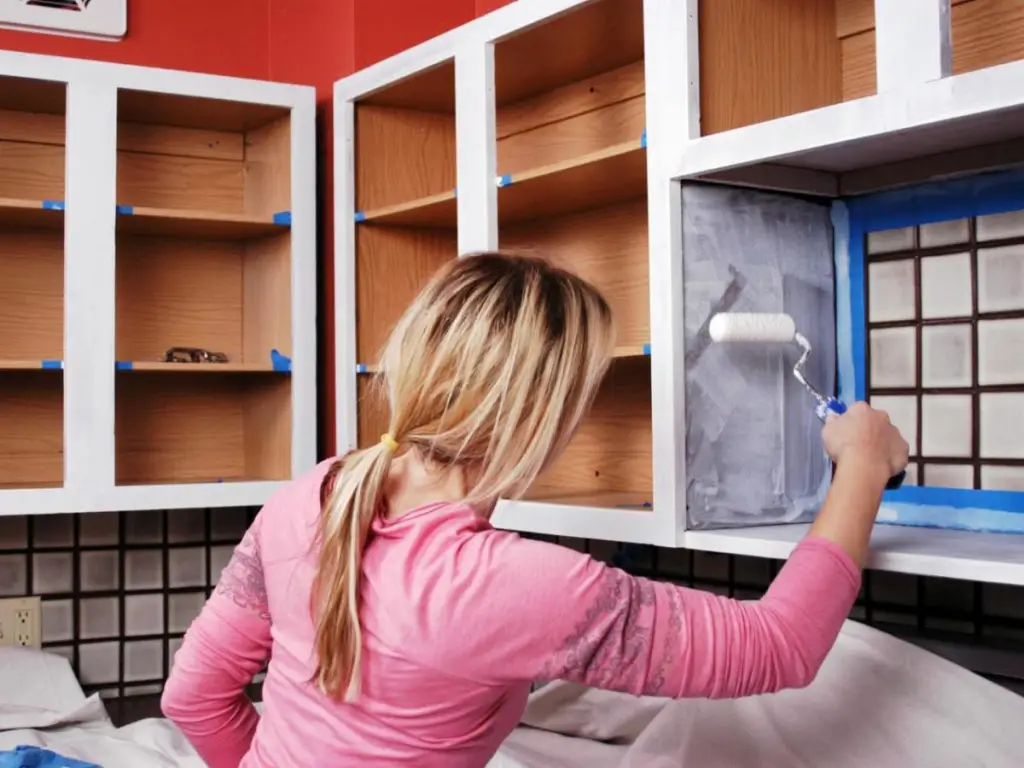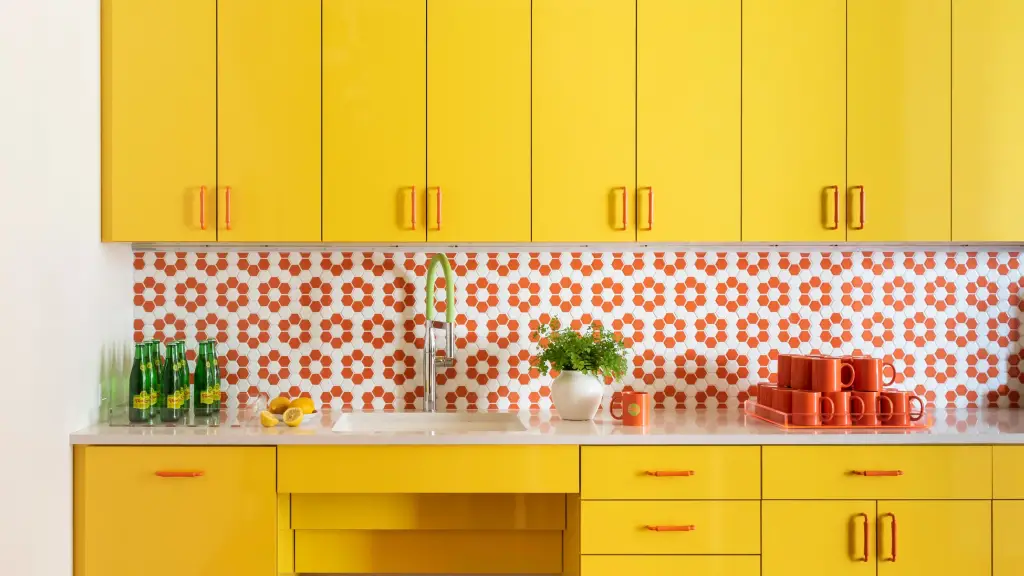Absolutely! Painting kitchen cabinets can dramatically improve your kitchen by adding color or freshness. Painting the insides of your cabinets may make a big difference in your kitchen’s design and create a cohesive effect.
Painting the inside of cabinets improves their appearance and resists deterioration. Fresh paint prevents moisture, spills, and stains on wood. A contrasting color for the interior of your cabinets can make your kitchen design stand out and convey your distinctive style

Have you ever thought about painting the insides of your kitchen cabinets to make your kitchen look different? Read this blog post to find out if it’s a good idea. Learn tips and tricks on how to do it, and see how adding some color can make your kitchen look better.
Checkout From Amazon
Determining Whether to Paint Inside Kitchen Cabinets
Table of Contents
Aesthetic Considerations
Before painting inside your kitchen cabinets, consider how the cooler will impact the look. Painting inside helps things coordinate and seem stylish. If you prefer a natural look, leave the insides unpainted.
Consideration:
- enhances the modern aesthetic
- Maintains rustic charm
Condition Evaluation
Check the insides of cabinets to see whether they require painting. If they’re old, dirty, or smell unpleasant after cleaning, painting may help. You may not need to paint them if they’re in decent condition and complement your style.
Consideration:
- Worn-out or stained cabinets may benefit from painting
- Well-maintained interiors might not require painting
Removing Doors and Hardware for Painting
Careful Removal Process
Remove kitchen cabinet doors and hardware before painting. This makes painting simpler without obstructions. Unscrew door hinges with a screwdriver. Label doors so you know where they go. This simplifies and speeds painting.
Thorough Cleaning Before Painting
Before you paint, make sure to clean the cabinet doors and hardware really well. Use soap to get rid of any dirt or grease. This helps the paint stick better and look nice when you’re done.
- Label each door for easy reinstallation
Clean doors and hardware before painting
Cleaning and Preparing Cabinets for Painting
Removing Grease and Grime
To start painting the inside of kitchen cabinets, it’s essential to clean them first. Mix a mild detergent with water to remove grease and grime buildup. Wipe down all surfaces thoroughly to ensure a smooth paint application.
Pros:
- Ensures better adhesion of primer and paint.
- Improves the overall finish of the painted cabinets.
Sanding Surfaces Lightly
After cleaning, lightly sand the cabinet surfaces. This step helps create a rough texture for the primer and paint to stick to effectively. Use fine-grit sandpaper in gentle circular motions.
Sanding allows for better paint adhesion.
It helps smooth out any imperfections on the cabinet surface. Prepares cabinets for a fresh coat of paint.
Priming the Inside of Kitchen Cabinets
Using High-Quality Primer
To paint the inside of kitchen cabinets, first use a special primer for wood. This helps the paint stick better and look nice. Use a brush or roller to put on the primer evenly.
Allowing Drying Time
Wait until the primer dries before applying another coat. The drying time between coats is vital for the best outcomes. Rushing might create paint bubbles, peeling, or an uneven finish.
Priming kitchen cabinets inside is essential for painting success. It keeps your paint color vivid and prevents chipping and flaking.
Applying Paint Inside Kitchen Cabinets
Choosing the Right Color
Use a color that matches your kitchen décor when painting cabinets. Colors should fit your kitchen’s style, such as white for modern or vibrant for fun. Match your cabinet color to your kitchen. For instance, paint the inside of your cabinets a similar color to match your light walls.
Applying Paint Evenly
Brush or roll latex paint inside cabinets for even coverage. Following the wood grain smooths the finish. Avoid thick coatings and look attractive with light layers. Paint cabinet interiors evenly with a spray gun. It protects cabinets without brush marks, shining them.
Choosing Whether to Use a Different Color Inside Cabinets
Creating Contrast

Your kitchen can appear cool with diverse cabinet colors. Painting white cabinets’ interiors navy blue might make them stand out. To test this theory, paint little portions different colors and see how they look. You can also consult an interior designer for color advice.
Maintaining Consistency
On the other hand, maintaining consistency by using the same color inside cabinets as the exterior creates a cohesive look in your kitchen. It gives a sense of continuity and unity to the overall design scheme. Lighter colors, such as soft greys or pastels, can make the interior space feel more open, airy, and spacious.
- Experimenting with sample colors
Consulting with an interior designer
Creating contrast vs maintaining consistency
- Lighter colors make spaces appear larger
Checkout From Amazon
Sealing the Inside Shelving of Painted Kitchen Cabinets
Adding Durability
Polyurethane or varnish on top of painted kitchen cabinets will prolong their life. This prevents damage and keeps them fresh. Put it on the right and let it dry as instructed. It is good because it lasts and resists scratches and stains. The downside is that clear material takes longer and costs more.
Minimizing Odor and Fumes
When picking a sealer for your cabinet shelves, go for a water-based one. It doesn’t smell as bad as the other kind, so it’s better for kitchens and small spaces.
- Follow the manufacturer’s guidelines.
Apply thin coats evenly.
Allow sufficient drying time between coats.
Mistakes to Avoid When Painting Kitchen Cabinets
Rushing the preparation process
Avoid hurrying kitchen cabinet painting preparation. Cleaning and sanding surfaces is essential for smoothness. Skipping this step can cause paint to chip or adhere poorly.
Taking time to clean and sand ensures that the paint sticks, giving you a professional finish. Rushing through this stage may save time, but it m cause problems later.
Rushed preparation may result in peeling or uneven paint application.
Properly cleaned and sanded cabinets provide a better surface for paint adhesion.
Skipping the priming step
Painting kitchen cabinets without priming is another big mistake. Primers protect the wood, making paint stick better and preventing chipping and peeling.
Priming gives your paint a smooth base, making it more durable and consistent across cabinet surfaces. Cabinet painting projects must include this phase.
Primer acts as a foundation for your paint, improving its adhesion.
Skipping primer may lead to poor paint adherence and premature wear of painted cabinets.
Tips for Hiring a Professional Painter
Research and Compare

When hiring a professional painter to paint the inside of kitchen cabinets, it’s essential to do your homework. Look at different painters’ portfolios, read reviews, and compare pricing. This step helps you find the best person for the job.
Research painters’ portfolios, reviews, and pricing
Compare different options before making a decision
Communicate Expectations
Communication is key when working with a painter. Make sure to clearly express your expectations and desired timeline for the project. By doing so, you ensure that both parties are on the same page from the beginning.
Request references from previous clients
Clearly communicate expectations and timeliness with the painter
Checkout From Amazon
Summary
Now you know how to paint kitchen cabinet interiors. Select colors, prepare, and paint like a master. Use different colors for fun. If unsure, employ a painter. Painting your cabinets will transform your kitchen!
Frequently Asked Questions
Can I paint the inside of my kitchen cabinets?
Yes, you can paint the inside of your kitchen cabinets to give them a fresh look. It’s a great way to revitalize your space without a full renovation.
Do I need to remove the cabinet doors before painting?
It is recommended to remove cabinet doors for easier and more thorough painting. This allows you to access all areas easily and ensures a smoother finish.
How should I clean and prepare my cabinets before painting?
Clean the cabinets thoroughly with a degreaser or soapy water, sand lightly, and make sure they are completely dry before starting to paint. Proper preparation is key to a long-lasting finish.
Do I have to prime the inside of my kitchen cabinets before painting?
Priming helps the paint adhere better and provides an even base coat, especially on bare wood or darker surfaces. It’s an essential step for achieving professional-looking results.
Should I use a different color for the inside of my cabinets?
What color you use within your cabinets depends on your design tastes. Matching colors provide a uniform kitchen, while contrasting hues add visual intrigue.